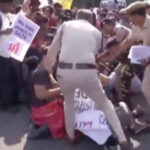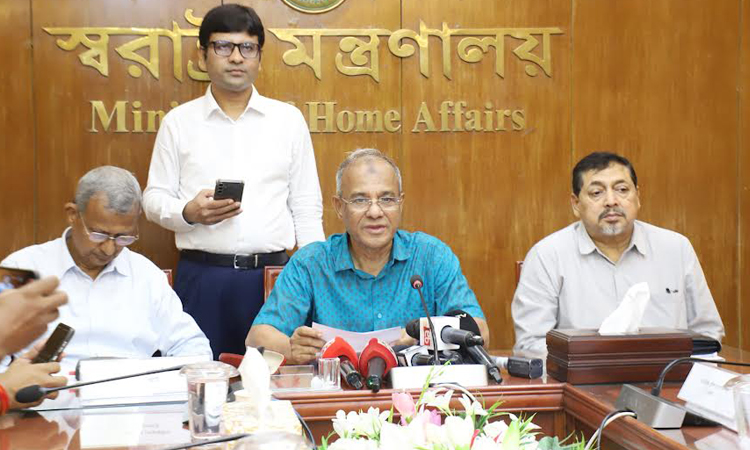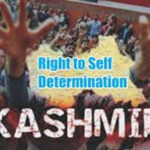A few forgotten Facts aout Haldwani’s Banbhulpura
Shruti Jain: The Supreme Court in its order dated January 5 stayed the demolition in Banbhulpura in Haldwani, where residents were declared to be “encroachers” on railway land and were served notices to vacate or face eviction as per an order of the Uttarakhand high court. The high court bench of Justices R.C. Khulbe and Sharad Kumar Sharma had mentioned a “need of immediate removal”, if need be by employing para-military forces, in its order of December 20, 2022. The apex court questioned how 50,000 people could be uprooted in a week, that too without any rehabilitation scheme.
The residents of Banbhulpura spent sleepless nights, unable to cook or eat, as announcements were made that they will be evicted by force as per the high court order if they do not vacate the homes in which they have stayed for generations. Children and women, leaving aside their school and domestic work, came out on the streets to hold candlelight marches and sit-ins, and gather for duas (prayers) pleading for mercy before the higher powers.
In panic, they were asking where could they go with the elderly, sick and very young in the bitter cold, leaving behind the warmth of a home and hearth, built with years of sweat, love and labour. The administration made sure through their drone cameras, and gathering of forces, that the people closely feel the threat that their whole world, and their past and future, will be snatched from them forcibly.
‘Why target us?’
Banbhulpura is largely a Muslim-dominated area. Thus, a question that locals like Sharafat Khan, a petitioner before the Supreme Court, raised when the eviction notices came on the very first day of the year was whether this was an exercise to target and single out a community. Locals wondered why the state government seemed ready to employ force, rather than standing with them.
Why were only their homes threatened with bulldozer action when there are bastis and habitations by the side of the about 20 km stretch of railway track extending from Kathgodam to Lal Kuan in Haldwani? Why was the state ready to demolish structures on which it has spent crores? Locals point out that there are five government schools, one health care centre, two banks, a huge water tank and other government institutions in the area.
Mohammad Aslam Qureshi, in his late 60s, said that the eviction seemed a part of divisive politics, which the area had not witnessed so far. The locals stress the fact that there has never been any tussle between the Hindu and Muslim populations in the area and they have been living together for more than a century. The area has about 100 Hindu families. It is strange to see that a Saraswati Shishu Mandir is running on the premises of the Shiv Gopal temple since 1980, where most of the students are Muslims.
In Banbhulpura, many structures are said to be 60-80 years to even a century old, including an old aara machine (saw mill), a mazar, a school and a few houses. Qureshi says that the meat market opposite his house was given a licence in 1919. A majority of the population are from lower income groups, and labourers can be seen standing at the chatri chowk.
The city of Haldwani depends on the area for all kinds of skilled workers, be it carpenters, plumbers, welders, tile workers, ironsmiths, motor mechanics, etc., besides going there to enjoy biryani and rumali roti. With the thelas and rehdis selling fruits, vegetables, rewdi, gur and clothes, and its many eateries, the ambience of the place reminds one of old Delhi. Banbhulpura is the major supplier of batasha and khilona on festivals like Diwali.
Banbhulpura is not a new habitation, with its history as old as that of the city of Haldwani; nor are Muslims outsiders to Haldwani. Historian Kiran Tripathi in her book Haldwani: Mandi se Mahanagar ki Or mentioned that in 1924-25, a zila parishad’s school had come up in Banbhulpura. The population of Haldwani in 1901, as mentioned in Nainital: A Gazetteer by H.R. Nevill (1904), was 6,624, out of which 3,327 were Hindus and 3,198 were Muslims. Once close to equal in numbers, slowly Hindus became the dominant population and Muslims are now residing only in specific localities like Banbhulpura.
From the name of Tripathi’s book, it is clear that Haldwani, which was a mandi of the mountainous Kumaun region of Uttarakhand, being its plain area, has over time developed as a metropolis in the Nainital district. Anand Vallabh Upreti in his book Haldwani: Smritiyon ke Jharokhe Se, narrates how this forest area of Haldu or Kadamba trees was a destination for Pahari cattle herders migrating there during winters, for van Gujjars, Muslim banjaras who were traders and for weekly bazaars. Being a trade centre for wood, rail tracks reached Kathgodam (a godown of wood) in 1884.
Banbhulpura locals say that first a private rail track by Dan Singh Maldar, a timber merchant, was laid there for his wood trade, which is why there is an old sawmill in their locality. Upreti mentions that Banbhulpura has some of the oldest houses of Haldwani. The house of Fida Hussain was the first nakkashidaar house (with carvings) of Haldwani that was constructed in 1942; Abdul Mazid built a house there in 1936.
Qureshi shares that it was Hemwati Nandan Bahuguna, a prominent Congress leader representing the hill region in the 1970s-80s, who named the area Azad Nagar after Maulana Azad. Upreti further relates how Azad Nagar was developed thoughtfully by then nagar palika chair D.K. Pande, on the lines directed by Britishers. For instance, fire lines were built after every four lanes.
Poor as “encroachers”
The main lane 17 of Azad Nagar has tall houses, schools, banks, shops and sewage lines. Apart from the old houses, many have constructed bigger houses over the years, with a few even taking loans. Some said that they are still paying instalments. They are the educated and better-off of the residents, who are arguing for their rights on the basis of documents. But moving towards the railway tracks, one comes across the malin basti or slum area. Gafur/Dholak basti residents’ traditional work was to make and repair dholaks, but many of them are now working as ragpickers or labourers. These bastis have smaller congested structures with cloth curtains as doors, narrow lanes and open drains.
It is right next to the railway tracks that there are the huts amidst heaps of garbage, which were earlier removed in 2007 by the railways but which over time returned to the same place. This last set of houses is the most vulnerable, but the residents still have a sense of security and community. It is still a home. What they need is a plan to improve their dwelling conditions or rehabilitate them properly, rather than taking away what little they have.
Faryaad Hussain in Gafur Basti says that most people in his neighbourhood are daily-wage earners; it is only when they work during the day that they can put a pot of food on the fire in the evening. The families were in deep trouble during the COVID-19 pandemic, and the eviction notices have added to their trauma and tension.
Upreti has related in his book how 70% of the land in the Haldwani town was nazul land, that is, government land given on lease to the holders. Many have made the land freehold over time, becoming its owners. This is also true for Banbhulpura. A majority of people have a patta (lease) of nazul land, and many of these have been converted into freehold property. Many have land deeds allotted by state authorities.
There are a few who had bought evacuee property through auction sales and have certificates issued by the Union Ministry of Rehabilitation in the 1950s. Waris Shah, a 60-year-old resident, says that most houses in his mohalla are on evacuee property, left behind by those who moved to Pakistan at the time of Partition. His house was first bought by a Hindu family in an auction in 1956 under the Displaced Persons (Compensation and Rehabilitation) Act, 1954 and then by him.
Mohammad Siraj Khan, who is a young person in the business of making steel cabinets, says that his family has documents to show their ownership of the plots. He claims that his ancestors have been living in the area for more than a century and shows documents on a stamp paper bearing the picture of Bahadur Shah Zafar. Sixty-year-old Azizan Bi says that they have been living in the area since before independence and have British sarkar ke kagaz.
The apex court has rightly observed that “There are multiple angles arising from the nature of the land, ownership of the land, the nature of rights conferred” in the case of Banbhulpura.
The residents claimed in their petitions to the Supreme Court that they have valid documents that clearly establish their title and occupation. Their names are in the municipal records and they are paying all kinds of taxes, including house tax, regularly. The state has provided them with gas and water connections and Aadhaar cards on their residential addresses.
In the context of arguments about encroachment in Haldwani, it is relevant to note that the town has developed and expanded in an unplanned manner in the absence of regulations, with no proper arrangements made for drinking water and sanitation. ‘Encroachment’ too is widespread, In fact, this holds true for large parts of Uttarakhand. After the recent Ankita Bhandari case, it had come to light how land in forests and on riversides has been encroached upon by hotels and resorts and illegal structures are run with impunity by the rich and affluent.
Why is it then that only the poor and minorities are targeted as encroachers? The poor have nowhere else to build their dwellings but on state-owned land. This happens with the full awareness of the modern surveillance state and its various agencies. However, the charges of encroachment and illegality are selectively put on a few and are driven by various political motivations. It adds to their vulnerability and is a failure of policy to push them thus to the brink of illegality.
Banbulapura was identified as an encroachment in a case that dealt with illegal mining in the Gaula river. Haldwani town has developed by the Gaula river and the railway track is also built along its banks. Gaula was earlier used to navigate wood, and later became the centre of trade related to mining. Mining in Gaula remains unregulated, affecting the river adversely.
In 2013, Ravi Shankar Joshi filed a Public Interest Litigation (PIL) in the high court seeking a ban on mining activities that he felt had become the reason for the huge Gaula bridge collapsing. The court in its decision of November 9, 2016, found the Banbhulpura people living by the bank of Gaula to be responsible for illegal mining, and encroaching upon railway land, and ordered their eviction.
The then Congress government sought a review of this order and later approached the Supreme Court, arguing that the land where encroachments were alleged belonged to the state and there was no demarcation of railway property. The issue of mining – Joshi’s initial concern – was sidelined in the later developments, even though the Gaula bridge was damaged again in 2021. Joshi again petitioned the court in 2022, pleading for action to remove the “encroachers”, leading to the December order of the high court.
During the arguments in the Court, the railways had claimed 29 acres of land. However, it demarcated 78 acres of land of Banbhulpura later on, that consists of a much larger population and many old habitations, as its property.
Mining in Gaula is an important revenue source for the state through licence fees, and for trades like stone crushing, and 17 stone crushers are registered in Haldwani. The forest department gives licences for mining, as the Gaula bed is considered a part of state forest produce. Throughout the year, sand, gravel and stones are scrapped out of the riverbed. Excessive mining has led to aggravated flood conditions that have ravaged railway tracks, bridges, farms and homes in the past in and around Haldwani.
Mohammad Islam, a 32-year-old resident of Gafur basti, shared that many of them are engaged as labourers in the mining work and carry out sand on the backs of mules and in horse-driven carts, or buggies. Shafiq Ahmed, a man in his 40s, shared that he has taken a gaadi by taking a loan for mining work.
When the state itself is giving licences to bigger contractors for mining and has failed to prevent illegal mining, is it reasonable to solely hold accountable the people of Banbhulpura, especially the residents of its malin bastis, for the situation of the Gaula river?
As many as 582 malin bastis (slums that are not regularised) have been identified in Uttarakhand, out of which 22 are in Haldwani. In 2016, the Congress government passed the Reforms, Regularisation, Rehabilitation, Resettlement and Prevention of Encroachment of the Slums Act and started a process for their regularisation/rehabilitation. However, the five bastis – Dholak basti/Gafur basti, Indiranagar Pashchimi A, B, and East, and Chirag Ali Shah – of Banbhulpura were removed from the process of regularisation in May 2022, for which purpose the Urban Development Directorate was holding a Geographic Information System survey to create a digital database.
Sartaj Alam, a local who is a journalist, asks how the present government could remove the bastis from the process when these were already notified. This shows the biased intent of the BJP government, which has stayed silent in the matter of Banbhulpura, even though to save other bastis in Dehradun in 2018, ordered to be evicted by the high court, it brought an ordinance, he says.
The locals are also pointing to the fact that apart from the BJP, all other political parties, including the Congress, Samajwadi party, CPI-ML, Uttarakhand Parivartan Party, etc. came out in their support.
Raja Bahuguna, a Communist leader, says that the government failed to show any accountability towards its citizens. Instead, it was ready for repression. A threat call was made by a SHO to the author of a poem on Banbhulpura posted on Facebook, asking the author to remove it as it gained traction. When Prime Minister Narendra Modi declared that all will be provided with pakka houses by 2022, why is it that instead we see a bulldozer rule, be it Banbhulpura or Jahangirpuri, he asks.
Waris Shah, while questioning the absence of support by the BJP, asked why it is that the Congress government had challenged the earlier high court eviction order, but the present government was making preparations to forcibly evict the people. What happened to its promises of sabka saath, sabka vikas? He feels that the eviction was a plan of the BJP to marginalise and clear out the Muslims from the area, frustrated that their 25,000 votes do not go to it.
S. Warsi, a 64-year-old resident, said that the government is exploiting them as part of a political conspiracy while making the railways a party.
Ravi Shankar Joshi, the petitioner in the case that led to the high court’s order, when asked about the intent behind his petition and whether he is associated with RSS as reported by certain platforms, denied such accounts.
Haldwani has been an important legislative seat after the formation of the state in 2000. It has remained a Congress stronghold, and Indira Hridayesh, its top leader, has repeatedly won from here in 2002, 2012 and 2017. After her death, her son Sumit Hridayesh won the seat in 2022, defeating Jogendra Singh Rautela, the BJP mayor of Haldwani Nagar Nigam, getting his maximum vote share from the Banbhulpura area.
Hridayesh had also contested for the mayor’s seat earlier but did not win. The demography of the Nagar Nigam is different from the legislative constituency of Haldwani, as it also includes some areas of the Kaladungi and Lal Kuan constituencies.
Rautela and Hridayesh are the two main political contenders of the Haldwani constituency. The eviction is also seen as an attempt to modify the demography of this constituency. When Rautela was approached to comment on the reason behind his silence as a mayor, and why the BJP government recused itself from the land dispute now, when the Congress government had supported the people earlier, he refused to comment on the issue.
Sumit Hridayesh, says that as BJP lost from only the Haldwani seat in the district, they are involved in vendetta politics. He said that the state government did not step up and speak up even when such a large number of families were asked to leave their homes in the bitter cold when many of them do not even have enough clothes to protect themselves.
On one side, there are accounts of conspiracy and Hindutva politics, but on the other side, Hindutva forces are blaming minorities for engaging in “land jihad”, a conspiracy theory that suggests that minorities are illegally encroaching upon properties as part of a campaign to displace Hindus and change the demography of devbhumi Uttarakhand.
The youth of the Banbhulpura area are angry with the section of the media who in the name of covering their plight, instead showed them as carrying out “jameen jihad.”
Such a theory had earlier come to light in August 2021, when BJP leader Ajendra Ajay wrote to chief minister Pushkar Singh Dhami to demand a new law to curb “land jihad”. Responding to this, the government had ordered state officials to mark such areas, and track “illegal land deals”. Hindutva leaders in the past have given calls to throw Muslims out of Uttarakhand to make it a state for Hindus exclusively.
While struggling with this political scenario, the Supreme Court order has afforded a sigh of relief for the residents of Banbhulpura, but the threat of eviction is still looming over their heads. In such a situation, will the state take any initiative to rehabilitate the slum areas and recognise the rights of the people who are settled there for three to four generations?
Author: Shruti Jain is an independent journalist and researcher.







